#set environment variables
Explore tagged Tumblr posts
Text
woah longstanding computer problem fixed by having the groundbreaking thought of "what if i googled the problem and attempted the solution that keep coming up in the search results"
#linux#for those wondering it was the lack of smooth scroll in firefox#and the solution was to set the environment variable MOZ_USE_XINPUT2=1#feels like it should be default in firefox but i'm sure there's good reasons why it's not
51 notes
·
View notes
Text
well i was about to say that trying to make windows do x11 forwarding is wasted effort, but it looks like xming actually does the job?!?!
#tütensuppe#i just had to test it#problem in windows is not that it doesnt work at all but that it only works once in a blue moon#so you might as well find a different solution#to me it looks like a problem with setting a specific environment variable#on other os the ssh sets this automatically to the correct value but in windows itll only work if the program#matches the value you set (very rarely)#anyway the guide i found describes how to use xming w putty which i dont like#but it also works using the standard terminal! (way easier to just use command line imo)
1 note
·
View note
Text
Doctor Trafalgar, Love Expert?
Law gives terrible love advice to Penguin while clearly ignoring his own painfully obvious crush on you.
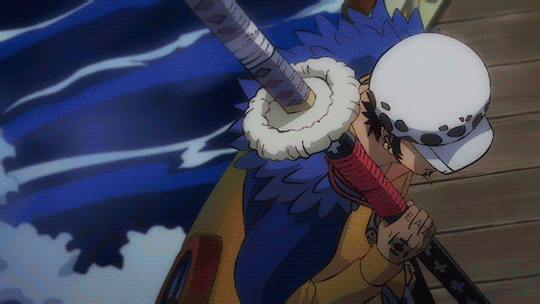
Law X gn! reader | ONE SHOT tags: fluff, sfw, friends-to-lovers typeshi(?) law being timid a/n: this js me trying to write ffs, this is experimental and for fun only, so expect this ffs a bit cringe word count: 1.1k
masterlist | ko-fi
: 𓏲🐋 ๋࣭ ࣪ ˖✩࿐࿔ 🌊

If there was one thing Trafalgar Law wasn’t qualified to do, it was give romantic advice.
Sure, he was a brilliant surgeon, a pirate captain, and had a smirk that could make a nun sin, but when it came to feelings—specifically his own—he was a flaming shipwreck in a storm of emotional denial.
And yet, here he was, arms crossed, giving unsolicited love advice to Penguin like he was the therapist from a soap opera.
“Just tell her she’s inefficient,” Law said with a straight face. “It’s a compliment.”
Bepo blinked up at him. “...Captain, I don’t think calling Penguin’s crush inefficient is going to help his chances.”
“You asked for honesty,” Law muttered, flipping through his medical journal like it was more interesting than this disaster in progress. “Efficiency is attractive.”
“To you, maybe!”
You, meanwhile, were watching this entire trainwreck from the galley door with a cup of tea and the kind of secondhand embarrassment that deserved its own trauma counseling.
“Law,” you called. “Did you just say ‘inefficient’ as a flirting tactic?”
He didn’t even look up. “It’s a practical compliment.”
You snorted. “What’s next? ‘Your presence improves my survival odds by 6.4%’?”
“…Depending on the environment, that’s a generous estimate.”
You and Bepo shared a look. A look that screamed, Why is this our captain?
The whole thing had started that morning when Penguin had walked into the common area in a flurry of nerves and confessed, “I think I like someone.”
Law, who’d been reading while pretending not to be listening to music in one earbud (yes, he still used wired ones, don’t ask), barely lifted his gaze. “Then tell them.”
Penguin shuffled. “It’s not that easy.”
“It’s the truth.”
“And what if they don’t like me back?”
Law gave the emotional equivalent of a shrug. “Then adapt. Rejection is survivable.”
Penguin groaned from the couch. “Cap, you can’t treat love like it’s battle tactics.”
“It’s a high-risk operation involving fragile variables and potential bloodshed. Sounds pretty accurate.”
Shachi nodded. “Okay, that’s fair, but also incredibly bleak.”
And that’s when Law was voluntold by everyone that if he was going to act like he knew how love worked, he had to give actual advice.
Hence: Doctor Trafalgar, Love Expert?
“Okay,” you said, taking the empty seat beside him and plucking the journal from his hands. “If you’re so good at giving advice, help me out.”
Law narrowed his eyes. “With what?”
“I think someone likes me,” you said casually, leaning back like you weren’t about to stir up the most delicious chaos. “But I can’t tell if they’re just awkward or trying to be subtle.”
His jaw tightened. “Who is it?”
You shrugged. “I don’t know. That’s why I need your expert opinion.”
Law closed the journal and set it down very deliberately.
Everyone in the room went very still. Bepo, Penguin, and Shachi exchanged silent screams with their eyebrows.
“Well,” Law said coolly. “What are the signs?”
“Hmm,” you hummed. “They hover a lot. Make excuses to talk to me. Kind of avoid eye contact but also stare when they think I’m not looking.”
His eye twitched. “Stare?”
“Yeah. And once, they brought me extra rice even though I didn’t ask.”
Silence.
Law stood up. “That’s suspicious.”
“Oh?”
“Sounds like they’re trying too hard.”
“Ohhh?” you said, biting back a smile.
“They’re probably nervous. Emotionally constipated. Bad at expressing feelings.” He said all this like he wasn’t describing himself to an absurdly accurate degree. “Possibly repressed.”
“Should I confront them?”
“No,” he said quickly, a little too quickly. “Absolutely not.”
“Why not?”
“It might scare them away.”
“But if they like me…”
“Then wait for them to say something first.”
Bepo coughed. “So… basically just let them suffer in silence?”
“It builds character,” Law said.
You covered your mouth to hide your grin. “You’re such a romantic.”
Law’s ears turned pink. “Shut up.”
Later that day, Shachi cornered you near the engine room with a look of deep judgment.
“You’re torturing him.”
“I have no idea what you mean.”
He pointed a wrench at you. “You know he likes you.”
“Do I?”
“You’ve been fake-flirting with a ghost for the last week just to get him to react!”
You smirked. “It’s good cardio.”
Shachi groaned. “He’s gonna combust. I saw him look up love confession rituals on his snail phone last night.”
Your eyes widened. “No.”
“Yes! And he accidentally joined a forum for single dads in North Blue.”
You wheezed. “He’s going through it.”
“So help him out!”
“…Fine.”
The opportunity came the next morning when you walked into the kitchen and found Law staring at a mug of coffee like it had personally betrayed him.
He didn’t look up when you entered, just mumbled, “Morning.”
“Morning,” you said, walking over. “Sleep okay?”
He made a grunt of vague disapproval.
You sat beside him. “Thinking about your crush?”
He choked on his coffee.
“I mean,” you said, oh-so-innocently. “That mystery person you gave advice about.”
His eyes narrowed. “You’re very nosy.”
“You’re very obvious.”
He gave you a look. “I don’t have a crush.”
You tilted your head. “Are you sure? Because everyone on this ship seems to think you do.”
“Everyone on this ship is bored.”
“Bored enough to notice how you go quiet when I talk, how you walk into rooms I’m in and pretend it’s for unrelated reasons, or how you stare at my lips when I eat dessert?”
He went dead silent.
You leaned closer. “So. Doctor Trafalgar. Any prescriptions for yourself?”
“…Shut up,” he muttered, face flushed.
You blinked. “Wait. That was a confession.”
He got up.
You grabbed his wrist.
He froze.
“Hey,” you said, suddenly softer. “I like you too, dumbass.”
He blinked.
You reached into your pocket and pulled out a little red candy. “I was going to make you say it first, but you looked like you were about to diagnose yourself with heartbreak.”
He blinked again.
“…You like me?”
“God, yes. Even when you’re being a brick wall with nice tattoos.”
“…I have more than just tattoos,” he muttered.
You grinned. “Yeah, you’ve also got a charming inability to express affection. It’s cute.”
He shook his head. “You’re insufferable.”
“You’re blushing.”
“I’m leaving.”
“You’re still holding my hand.”
Pause.
He looked down.
He was.
“…Tch.”
You laughed and tugged him back down. “Stay.”
“…Fine.”
Later, Penguin came in to find the two of you sitting shoulder to shoulder, quietly sharing a plate of snacks.
“Captain?” Penguin said, tilting his head. “Did you take your own advice?”
Law didn’t look up. “No.”
You grinned. “He took mine.”
#one piece#one piece x reader#one piece x you#one piece x y/n#idk man#fluff#idk what im doing#trafalgar law#trafalgardwaterlaw#trafalgar one piece#trafalgar d law x reader#trafalgar op#law x reader#trafalgar law x reader
1K notes
·
View notes
Text
Installasi dan Setting Android SDK Tanpa Android Studio
langkah setelah kamu menginstall flutter maka selanjutnya melakukan installasi dan setting android SDKnya. berikukt langkah-langkahnya : Buka link https://developer.android.com/studio dan scroll ke bawah hingga menemukan command line tools only tanpa perlu android studio Langkah selanjutnya silahkan download sesuai sistem operasi, jadi saya akan pilih windows untuk commandlinetoolsnya. setelah…
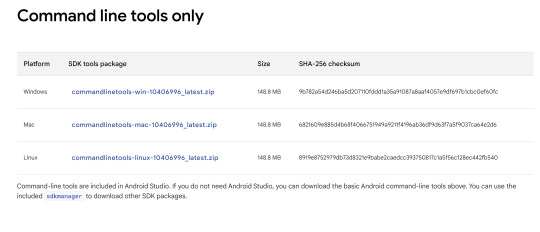
View On WordPress
#environment variables#instalasi android sdk#install flutter#sdkmanager#sdk_android_root#setting android sdk#vscode tanpa android studio
0 notes
Text
Avoiding Plot Holes by Seeding Doubt
Having an “expert” character conveniently fuck up right when the plot needs it to happen, when they otherwise would never, always loudly looks like the hand of the author sabotaging things. Which is exactly what’s happening.
However, if you set up that scene in a way where that fuckup is possible and warranted, you can turn “this is so contrived” to “omg I knew that was going to happen”.
Some suggestions!
Firstly, if we’re dealing with humans, humans are not machines. Variability in skill even at the expert level happens. Go watch the Olympics or any professional sporting event and people have terrible days all the time.
In fiction, a conveniently terrible day because that’s just how this works doesn’t fly. Diablos ex machinas tend to go over easier than deus ex machinas, but a character failing at a critical challenge in the narrative for no reason screws with a lot of the tension and expectations. “For no reason” takes no effort by the author to set up and pay off, and it reads as cheap.
Behavioral variables
I am a novice archer. I write expert archers. I do not write supernaturally accurate archers. From the very beginning of my story, my expert, with four centuries of experience, isn’t nailing perfect kill shots with every hit. A) he doesn’t need to and B) leaving his enemy to die slowly and painfully is a low he will absolutely stoop to if he thinks it’s warranted.
He’s as good as he has to be and if he gets the job done, he doesn’t care if it’s a little messy. Him being messy and overconfident is what gets him in the end, too. If he’s trying, he’ll do better, but most of the time “eh, I got close enough, they’ll die eventually” is his mindset.
“Expert” in fiction being “this is a character who will reliably pass the challenges set up for them by the narrative”.
So if you have an “expert,” allowing them to get a little bit lazy and overconfident, or simply not think of themselves as needing to be perfect in a given situation, you allow yourself a lot of wiggle room for them to majorly fuck up.
Doesn’t work very well if I throw my archer into an archery tournament, but I haven’t done that, and I’ll get to that later.
Environmental variables
Using the archery example once again: Archery is finnicky and precision is key. So if you’ve got your archer, or any marksman, in a windy environment, they have to work that much harder to factor in the wind when setting up their shot.
If it’s rainy, or the sun’s in their face, or it’s dark, or it’s loud and they can’t focus, these things aren’t exact data points the audience is going to do the math on. Or, if they and their enemy are moving, which, in combat, is highly likely.
Physiological variables
Maybe your character didn’t get enough sleep, or they’re stressed about this moment, they’re cracking under the pressure, they’re doubting themselves, the enemy got into their head, or they’re distracted worrying about something else. Or they got drunk the night before, they ate too much or too little. They’re sick, their hands are sweaty, they’ve got a sinus headache. They’ve got cramps, or hot flashes, or earlier they pulled a muscle and it still tweaks.
These are all, once again, introducing doubt into the narrative so that, when they fuck up as the plot demands, the audience should consider “well they weren’t at their best, I believe it”.
—
The sloppy way to do this is to go, in the moment:
“But because it was windy, X missed his shot”.
Is this the first time the reader is learning that it’s windy? Pretty convenient to introduce it right as it becomes important.
Rather, establish your variable beforehand in a disconnected moment. Try to ground it to a different element, otherwise it might look like it’s being mentioned for no other reason than “this is important”. Or, if it’s environmental, bury it with the other sensory descriptors.
When establishing the scene and setting, casually mention how the wind is interacting with the characters—making their hair a mess, throwing pollen everywhere, making skirts billow, etc.
Have another character complain about this variable bothering them
Have the character instantly regret the decision they made the night before for unrelated reasons. Like, if they got drunk, now they’ve still got a headache.
Depends on the story and the audience, of course, but I personally think having the narrator explicitly call out the variable fuckery going on reads a bit hammy. I like letting the audience figure out what went wrong with the clues I give.
If the scene demands, I'll also let my characters get annoyed and upset about their shots going wrong and blaming the environment. So long as it's not "hand of the author here to tell you what went wrong" you've got options.
I wouldn’t pull this trick too many times, otherwise your “expert” ends up consistently not an expert and then their sudden success looks suspect and contrived.
If you are writing some sort of tournament where this character is deliberately setting themselves up for success and is considering all these variables… a great example I like is Todoroki vs Bakugo in My Hero Academia season 2.
Dude is an uncertain mess throughout the rest of his tournament once his “fuck you dad I’m gonna win by half-assing it” suddenly isn’t enough to beat Midoriya. He’s forced to face some Tragic Backstory and it throws him off his game—establishes doubt.
He has a string of successes once he starts taking baby steps with the other half of his powers, and in the finale, he’s up against someone where he really does have to give it his all if he wants to win. His brute force powers are up against someone who has honed his very specific and powerful abilities for a decade.
And he can’t do it.
The final fight stops being a matter of power metrics and who would win if they both were competing at their best with all the tricks in their playbook available, which is what most of the tournament had been up to this point.
Basically—it stops being a numbers game, and starts being an emotional one. If you have a character you need to fail at something, but who wouldn’t otherwise, consider shifting the battle from external to internal, so the task failure is just the catalyst for the real meat of the story: what this loss means to this person in the long run.
**Side note there are of course a ton of anime tournament fights probably better than this one, Rock Lee’s whole arc against Gaara is one of them, I just don’t remember it well enough to comment on it.
Not every reader is going to be savvy enough to go “well that’s going to be important later”. Use betas and editors to help gauge how vague or obvious your foreshadowing is.
But even if you have readers sussing out your foreshadowing: Part of the fun is figuring out how the journey will end, even if we know when and where. Otherwise tragedies and prequels wouldn’t be made.
The dramatic irony of knowing variable fuckery is at play when the character is unaware can be so fun as the audience. Horror films are kind of built on it.
#writeblr#writing#writing a book#writing advice#writing resources#writing tips#writing tools#plot holes#foreshadowing
876 notes
·
View notes
Text
Romance with the Alchemist.

pairing: albedo x reader
warning: not proofread, rough draft, grammatical erroes (i think), wrote this like a year before and continued it on the spot so it's going to be a bit confusing but anw idc i js need to delete these drafts mehn HWIEHDJWJAH.


It began with a cup of tea.
Not yours—his. Albedo had brewed it, left it on the table, and forgotten about it amidst a string of calculations. You passed by, noticed the cup, and without a word, picked it up, warmed it again over the flame, and set it beside him with the gentlest clink.
That was the first data point. He didn’t write it down, but it stayed. He told himself it was curiosity at first.
You behaved unlike the others who visited Dragonspine. You didn’t press him with questions, didn’t ask for favors or boast about surviving the cold. You were…quiet, in your own way. Attentive without demanding. Present without pulling.
A quiet variable that returned, again and again. He found himself measuring time in your visits. Not in hours or days, but in the way the cave brightened when your boots left shallow prints by the door.
Noted. Unspoken.
Albedo’s affection bloomed not like fire, but like frost—slow, creeping, unnoticed until everything beneath was touched by it. He began adding a second chair beside his. “In case Timaeus visits,” he said. But he never offered it to Timaeus. Only to you.
He stored a second blanket in the corner—“for emergencies.” You used it once. After that, it was always folded neatly at arm’s reach from your favorite spot. These weren’t declarations. These were constants. Quiet insertions into his environment that proved your presence was not only expected, but accounted for.
The acceptance came not with a realization, but with a recalibration. One night, after you left with a soft wave and a promise to return “next week, maybe,” he found his mind drifting. Not to your face.
But to your voice, saying “next week.”
To your hand brushing his wrist as you passed something he needed.
To the warmth of your scarf still left behind on the hook.
He stared at it for a long time.
Then, without a word, he hung it next to his coat.
It was in the way he started pacing when your return was delayed. The way his brush hovered above the page, unsure whether to draw the tree outside… or the way he could see your breath on the cold air as you looked at something from the distance.
He never called this feeling to be something possibly like romance or affection, he does not believe he could feel such emotions.
But he stopped testing it. Stopped resisting the instinct to brew tea for two. To write notes in the margin for you to find. To reach for the scarf you gave him even when the cold didn’t bite.
One evening, you fell asleep near the campfire in his lab, book in hand, cheek resting against your arm. The silence was soft, comforting.
Albedo didn’t move you. He sat, watching the snow beyond the entrance, the curl of your fingers against the page. And for the first time, he allowed himself to speak aloud—not to wake you, not to be heard, but simply to let it exist:
“Stay as long as you’d like.”
It was not an invitation.
Not a request.
But it was a hypothesis proven true, quietly, patiently: In a world of shifting truths and elusive formulas, you had become the one constant he never needed to solve—only preserve.
To be honest, the snow never bothered Albedo.
Most avoided Dragonspine unless they had no choice, but not him—and not you, either, much to his quiet surprise the first time you trudged through the thick frost just to bring him a scarf. It was hand-knitted, a little uneven in stitching, dyed a blue that didn’t quite match his usual palette. You apologized for it, babbling that you weren’t sure he’d like it, but—
He took it from your hands, wore it immediately, and didn’t say a word. But he wore it again. And again. Every time you visited. You never noticed the way his gloved hand would linger over the fabric when you left. He made sure of that.
Albedo didn’t love like others did.
There were no grand proclamations. No impulsive touches or clumsy declarations. He didn’t stumble over his feelings or turn crimson at your smile. Instead, he observed you—like an unsolvable equation that he didn’t want to solve too fast.
He remembered the way you liked your tea: a dash of honey, not sugar. So when you visited the lab, a steaming cup always waited near the heat lamp. He noted the books you skimmed in the library, then borrowed them in secret, reading ahead so you could “coincidentally” discuss them together.
He never said the words. But he showed them in ways he knew how—through routines, through precision, through the silence between thoughts where your name lingered like an echo.
One afternoon, you arrived while snowflakes danced lazily outside, clinging to your cloak. “You’re not cold?” you asked, setting down a wrapped lunch you made for the both of you.
“I’m adjusted to this climate,” he answered without looking up, yet he slid a warmer chair closer to the heater for you. “But you should be careful. I noticed your gloves are worn. I’ve… made you a pair.”
You blinked. “You made them?” He nodded. “Woven from wool. Reinforced with wind crystal shards. A minor alchemical enhancement for warmth retention.”
You laughed softly, slipping them on. “They’re perfect.” He turned away too quickly. “I’m glad.” He never said the three words. He didn’t need to. The way he watched you with steady, unwavering eyes—the way he noticed what even you didn’t—said it all.
It wasn’t until much later, when you found an old sketchbook half-buried under his pile of notes, that you truly saw it. Pages and pages of you. Not exact portraits, but impressions—the curve of your hand holding tea, the softness in your gaze when you looked at snow falling outside his window, the tilt of your head when you read aloud.
Each drawing carried a different kind of tenderness. And at the corner of one, written in his delicate script: “Hypothesis: In the presence of [Name], the concept of home shifts. It is no longer a place, but a person.”
When it came to everyone and their thoughts regarding the both of you, Lisa knew first. Of course she did.
You visited the library one afternoon looking for a book Albedo had once mentioned in passing—Floral Properties of Subzero Climates, Vol. II. You didn’t ask for it by name. You simply described the way his voice softened when he last spoke of it.
Lisa smiled, handed it over without a word, and watched you leave with a knowing hum. “That boy…” she murmured. “Head over heels in his own way.
Kaeya noticed when he caught Albedo adjusting his gloves one evening at the tavern. “You’re headed back to Dragonspine, aren’t you?” Kaeya asked. “Say hello to our favorite snow visitor for me.”
Albedo blinked once, the way he did when caught off-guard. “You mean Timaeus?” Kaeya chuckled. “Sure. Timaeus.” But Albedo didn’t argue. He just quietly picked up the satchel with two thermoses inside—one with his usual tea, the other with yours.
He wouldn’t call it affection. But he made sure the one labeled with your initials was sealed better, warmer.
Sucrose found one of your hairpins tucked into the corner of Albedo’s desk. She reached for it absentmindedly, only for Albedo to stop her gently. “That’s not… for use,” he said.
“Oh.” She blinked. “It’s the traveler’s, right?” Albedo didn’t answer. He just took it and placed it into the locked drawer where he kept his most fragile samples. Not because he wanted to hide it—but because things that mattered should be protected.
You never talked about what it meant. When you arrived, you simply sat beside him. Sometimes you read. Sometimes he painted. Sometimes you both just existed in quiet parallel.
But small things kept building up.
The sketchbook left open where he knew you’d peek.
The comment you’d drop about something he made—just enough to make him pause, the corners of his lips curling slightly.
Once, you brought lunch and forgot utensils. Without hesitation, Albedo offered his own.
Two hours later, he was still touching the spot where your fingers had grazed his.
Amber visited one time and caught the two of you mid-conversation—or rather, mid-silence. You were both just sitting, sipping tea, watching the snow fall outside. Nothing romantic, at first glance.
But then Albedo leaned closer, brushing a stray snowflake from your shoulder without breaking eye contact. You didn’t flinch. You smiled, like it was the most natural thing in the world.
Amber blinked. “Wait,” she whispered under her breath. “Are they…already dating?”
You weren’t.
Neither of you said anything.
But everyone could see it and they had bet on it. In the way Albedo set aside a space for you in every part of his world. In the way your laugh softened his features in a way no potion or pigment ever could. Still, the words were never spoken.
Not when he adjusted your scarf before you left.
Not when you left him your gloves by mistake and found them cleaned and folded neatly in your bag the next morning.
Not even when he handed you a notebook one day—filled with formulas, sketches, pressed flowers, and on the last page: “Certain variables defy classification. I’ve stopped trying to define what you are to me. I’ve decided instead…to keep you.” There was no name on it. But you knew.
And when you returned the next day, you didn’t say anything either. Just sat beside him like always, eyes shining a little brighter.
And he, ever subtle, simply handed you your cup.
Still warm. Still waiting.
#nyx — writes.🖊️#genshin impact#genshin x reader#genshin impact x reader#albedo scenarios#albedo gi#albedo kreideprinz#genshin impact albedo#albedo fic#albedo x reader#albedo#genshin blog#genshin imagines#genshin impact scenarios#genshin x you#albedo kreideprinz x reader#i have returned#bitchass this is so shit PLSHWIAHDHDBA
559 notes
·
View notes
Text
I want a human zoology textbook.
Zoology, as in the study of animals. Like, a study of how humans work, done by an author that is not human.
I specifically want this for a couple reasons:
1. Descriptive, not prescriptive: don't tell me what the author thinks humans should do or how they should be. Tell me what they do. Observationally!
2. No bias towards "nature". I don't particularly care what the author is imagining humans are like in some "garden of eden" unfallen state. I want it to reference how humans ARE.
3. No morality applied to this! What do humans DO, not what you think they should do, or how they should be. And most importantly, no self-censorship in order to avoid offending some of the humans that disagree with ways people live.
And the reason I want this is because of how biology textbooks/wiki pages get written, where even if they try to be progressive they're still written from this weird perspective where they're explaining based on old ideas and the progressive stuff gets a footnote.
Like it'll be "humans have two genders, male and female. This is determined from their chromosomes, XY for male and xx for female."
And then you scroll past two pages for men and another two pages for women, and then it has one subsection that covers non-binary people and intersex people. And it's like: well then integrate that into your main statement!
It's like the author's worldview is still "there's two genders and everyone is born as one" but they've been forced to accept there are some weird exceptions but the core worldview is unchanged. And it's understandable! Wrong, but understandable: the grew up in a world that is quite strong on the "there are only two genders" ideology and doesn't like to remember that intersex people exist.
But like, imagine if you tried to do this as a zoologist. You're like "hey, all bees are female!" and then someone points out the rare male drones and they're like "oh okay I'll update my zoology textbook."
And now it reads:
All bees are female. Most are workers, and one is the queen.
(a couple sections go pass)
Drones: recent science has discovered that some bees are born male. These rare exceptions live short lives where they fertilize a queen and then die.
And it's like, no? Drones are very important to how a hive lives and they can't survive without them?
And we're constantly doing the same thing to humans and it's just bad science. Like, sure, maybe you could have the theory that "humans come in two genders: male and female" but as soon as you see one non-binary person, you have to discard that theory: it has been proven false! It's like not believing in other galaxies after Henrietta Swan Leavitt figured out how Cepheid Variables worked.
Add to that the "nature" thing. Like, you can make a sort of argument about nature vs artificial settings for a lot of species: the whole alpha/beta wolf thing came about because it turns out wolves act differently in captivity compared to the wild, so it makes sense to study how the vast majority of wolves live, not a small group you stuffed into a small area with unusual conditions. It's like saying the lifespan of goldfish is under 5 minutes, based on your study of them in this dry box you put them in.
But humans are different: we are tool-users who build new environments for ourselves. And while you can talk about how humans living in different environments act differently, it doesn't make a lot of sense to call one of them "artificial". All of them are made by us, and humans always do this. This means all environments are natural (because building environments for ourselves is what we naturally do) and all environments are artificial: we always alter our environments to better suit us! That's one of the things we naturally do!
And as for morality, it's about not ignoring things humans do regularly because you think it's weird or you think they shouldn't.
Like that tweet where someone pointed out that lots of species can change gender. Clown fish are a big one, some frogs, a couple birds, some lizards, and humans.
And people often have an immediate knee-jerk reaction of "that doesn't count!" for the last entity in that list. Why? Because we do it (usually) with clothes and makeup and medication, instead of just "naturally"? Bullshit. We're naturally TOOL USERS. Of course we use tools to change gender. We use tools to do EVERYTHING. That's natural for us.
So yeah. I think it'd be refreshing and enlightening to have a zoology textbook written about humans with this detached non-human perspective. An unbiased description of what humans are and do, rather than one irrevocably tinged with ideas of what humans should be and should do.
Basically I want to load up Vulcan Wikipedia and check the "Humans" article.
690 notes
·
View notes
Text
How to run The Sims 3 with DXVK & Reshade (Direct3D 9.0c)

Today I am going to show you guys how to install Reshade and use Direct3D 9.0c (D3D9) instead of Vulkan as rendering API.
This tutorial is based on @nornities and @desiree-uk's awesome guide on "How to use DXVK with The Sims 3", with the goal of increasing compatibility between DXVK and Reshade. For users not interested in using Reshade, you may skip this tutorial.
If you followed nornities and desiree-uk's guide, it is strongly recommended that you start from scratch, meaning you should uninstall DXVK AND Reshade completely. Believe me when I say this: it will save you a lot of time, frustration, and make your life so much easier.
For the purpose of this tutorial, I am on patch 1.69.47 and running EA App on Windows 10, but it should work for version 1.67.2 on Steam and discs, too. This tutorial does not cover GShade.
Before we start
Backup your files, even the entire folder (Program Files\EA Games\The Sims 3\Game\Bin) if you want to be extra safe; you will thank yourself later. If you do not wish to backup the entire folder, at least backup the following:
reshade-presets
reshade-shaders
Reshade.ini
Options.ini (Documents\Electronic Arts\The Sims 3)
Keep them somewhere secure, for your peace of mind (and sanity).

Done? Great stuff, let us begin!
Step 1:
If you installed DXVK following nornite and desiree-uk's guide, go to the bin folder and delete the following files to fully uninstall DXVK, we are starting from scratch:
d3d9.dll
TS3.dxvk-cache
dxvk.conf
TS3_d3d9.log (or TS3W_d3d9.log)
Step 2:
If you already have Reshade on your PC, uninstall it using this: https://reshade.me/downloads/ReShade_Setup_X.X.X.exe (replace X.X.X with version number)
Step 3:
Perform a clean install of Reshade (I am using the latest version - 6.4.1 at the time of writing). Please note that you need a version no older than 4.5.0 or this method will not work. Choose DirectX9, click next.
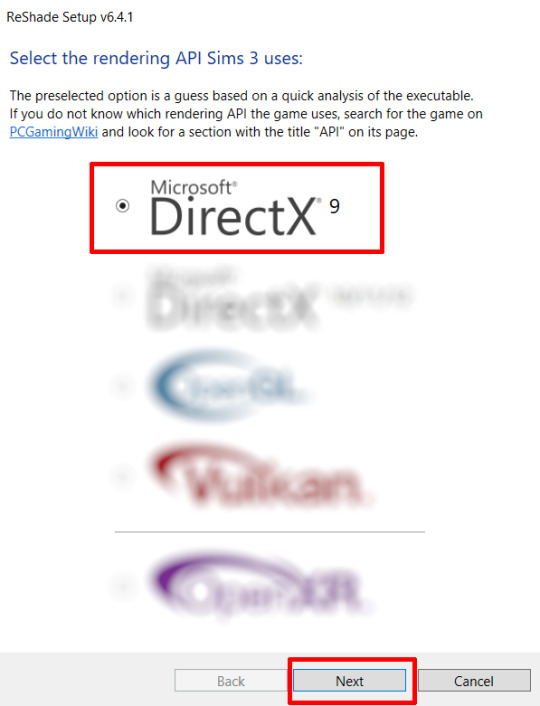
Once the installation is complete, you should see a "d3d9.dll" file inside The Sims 3's bin folder (Program Files\EA Games\The Sims 3\Game\Bin):
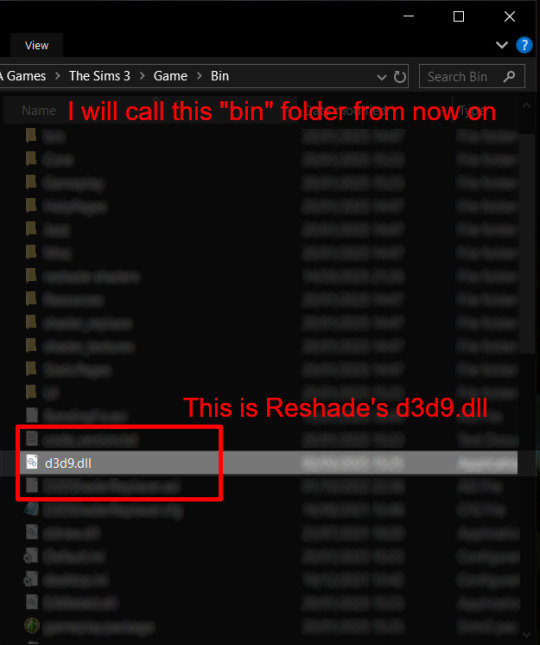
It may all seem familiar thus far. Indeed, this is how we installed Reshade in the past before using DXVK, but here comes the tricky part:
Step 4:
Create a new folder outside of The Sims 3's game folder (I created it on my C drive), name it "dxvk" or whatever else you like. Remember where you saved this folder, we will return to it later.
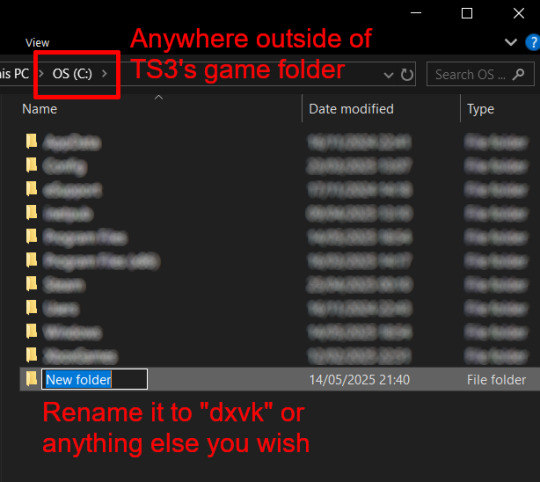
Step 5:
Now we need Reshade to load the next dll in order to chain Reshade with DXVK. Click on the search bar, and type in "View advanced system settings".
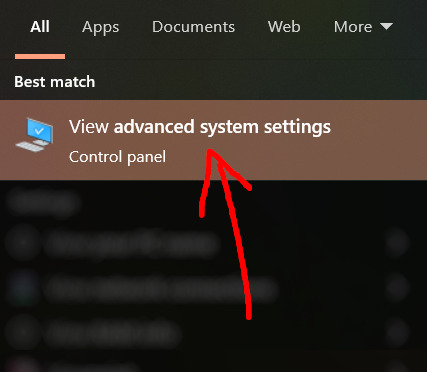
Click on "Environment Variables..."

Under "User variables", click "New..."
In the new pop-up window, find "Variable name:" and type in:
RESHADE_MODULE_PATH_OVERRIDE
for "Variable value:", paste in the directory that leads to the folder we created earlier. Once you are done, hit OK, and then hit OK again to save the changes made.
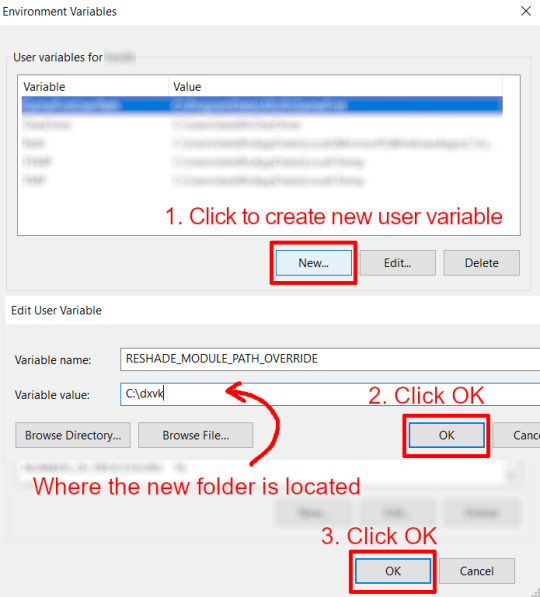
You can use Command Prompt to check if this new environment variable has been registered by entering:
echo %RESHADE_MODULE_PATH_OVERRIDE%
It should return you the folder's location. If not, make sure you have typed in the variable name correctly and confirm the folder's location.
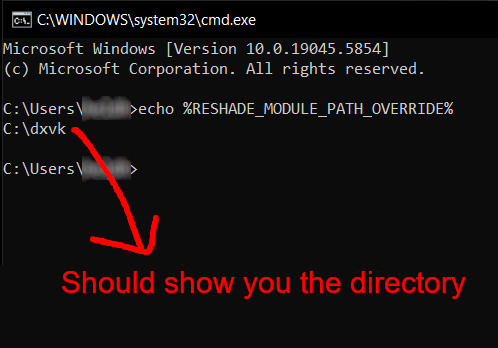
Step 6:
Download DXVK (version 2.3.1) from here: https://github.com/doitsujin/DXVK/releases/tag/v2.3.1 and unzip "dxvk-2.3.1.tar.gz" (I use 7-Zip, but winRAR works, too). Remember to choose x32, and move only "d3d9.dll" to the folder we made earlier.
Now we have two "d3d9.dll" files, one from Reshade (lives in the bin folder), and the other from DXVK (in this new folder, outside of The Sims 3 game folder).

Step 7:
Download "dxvk.conf" here: https://github.com/doitsujin/dxvk/blob/master/dxvk.conf delete everything inside, and enter the following:
d3d9.textureMemory = 1 d3d9.presentInterval = 1 d3d9.maxFrameRate = 60 dxvk.hud = devinfo
Ctrl + S to save the document.
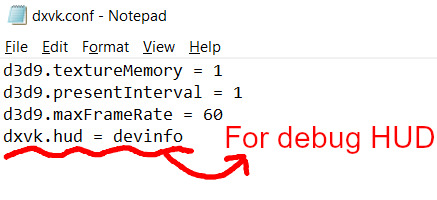
The first 3 lines are taken from @nornities and @desiree-uk's guide.
The last line is only for debugging purposes. Due to the inconvenient location occupied by the HUD (top left corner of your screen), it should be removed once the installation is successful.
Step 8:
Drag "dxvk.conf" into the bin folder, where Reshade's "d3d9.dll", "TS3.exe", and "TS3W.exe" all live.

Step 9:
Now fire up the game and check if both are showing up:

Lastly, check for “TS3.dxvk-cache” in the bin folder:
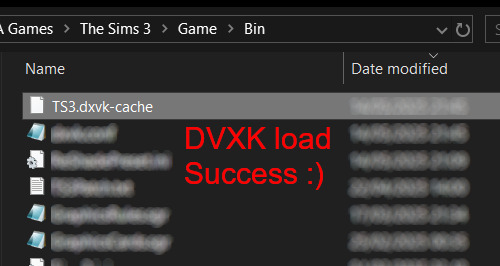
If it is there, congratulations! You have successfully installed DXVK and Reshade utilising D3D9 as API! You can now go to "dxvk.conf" and remove its last line "dxvk.hud = devinfo" and have fun! :)
Hope this tutorial isn't too confusing, the last thing I want is to over-complicate things. If you still need some help, comment down below or send me a DM/ask, I'll try and troubleshoot with you to the best of my ability.
Credits:
@nornities and @desiree-uk for their fantastic guide.
@criisolate for promulgating the usage of DXVK in TS3 community.
reddit user folieadeuxmeharder for helping me troubleshoot and informing me of this workaround.
doitsujin for creating DXVK.
crosire for creating Reshade.
143 notes
·
View notes
Text
DXVK Tips and Troubleshooting: Launching The Sims 3 with DXVK
A big thank you to @heldhram for additional information from his recent DXVK/Reshade tutorial! ◀ Depending on how you launch the game to play may affect how DXVK is working.
During my usage and testing of DXVK, I noticed substantial varying of committed and working memory usage and fps rates while monitoring my game with Resource Monitor, especially when launching the game with CCMagic or S3MO compared to launching from TS3W.exe/TS3.exe.
It seems DXVK doesn't work properly - or even at all - when the game is launched with CCM/S3MO instead of TS3W.exe/TS3.exe. I don't know if this is also the case using other launchers from EA/Steam/LD and misc launchers, but it might explain why some players using DXVK don't see any improvement using it.
DXVK injects itself into the game exe, so perhaps using launchers bypasses the injection. From extensive testing, I'm inclined to think this is the case.
Someone recently asked me how do we know DXVK is really working. A very good question! lol. I thought as long as the cache showed up in the bin folder it was working, but that was no guarantee it was injected every single time at startup. Until I saw Heldhram's excellent guide to using DXVK with Reshade DX9, I relied on my gaming instincts and dodgy eyesight to determine if it was. 🤭
Using the environment variable Heldhram referred to in his guide, a DXVK Hud is added to the upper left hand corner of your game screen to show it's injected and working, showing the DXVK version, the graphics card version and driver and fps.

This led me to look further into this and was happy to see that you could add an additional line to the DXVK config file to show this and other relevant information on the HUD such as DXVK version, fps, memory usage, gpu driver and more. So if you want to make sure that DXVK is actually injected, on the config file, add the info starting with:
dxvk.hud =
After '=', add what you want to see. So 'version' (without quotes) shows the DXVK version. dxvk.hud = version

You could just add the fps by adding 'fps' instead of 'version' if you want.

The DXVK Github page lists all the information you could add to the HUD. It accepts a comma-separated list for multiple options:
devinfo: Displays the name of the GPU and the driver version.
fps: Shows the current frame rate.
frametimes: Shows a frame time graph.
submissions: Shows the number of command buffers submitted per frame.
drawcalls: Shows the number of draw calls and render passes per frame.
pipelines: Shows the total number of graphics and compute pipelines.
descriptors: Shows the number of descriptor pools and descriptor sets.
memory: Shows the amount of device memory allocated and used.
allocations: Shows detailed memory chunk suballocation info.
gpuload: Shows estimated GPU load. May be inaccurate.
version: Shows DXVK version.
api: Shows the D3D feature level used by the application.
cs: Shows worker thread statistics.
compiler: Shows shader compiler activity
samplers: Shows the current number of sampler pairs used [D3D9 Only]
ffshaders: Shows the current number of shaders generated from fixed function state [D3D9 Only]
swvp: Shows whether or not the device is running in software vertex processing mode [D3D9 Only]
scale=x: Scales the HUD by a factor of x (e.g. 1.5)
opacity=y: Adjusts the HUD opacity by a factor of y (e.g. 0.5, 1.0 being fully opaque).
Additionally, DXVK_HUD=1 has the same effect as DXVK_HUD=devinfo,fps, and DXVK_HUD=full enables all available HUD elements.
desiree-uk notes: The site is for the latest version of DXVK, so it shows the line typed as 'DXVK_HUD=devinfo,fps' with underscore and no spaces, but this didn't work for me. If it also doesn't work for you, try it in lowercase like this: dxvk.hud = version Make sure there is a space before and after the '=' If adding multiple HUD options, seperate them by a comma such as: dxvk.hud = fps,memory,api,version
The page also shows some other useful information regarding DXVK and it's cache file, it's worth a read. (https://github.com/doitsujin/dxvk)
My config file previously showed the DXVK version but I changed it to only show fps. Whatever it shows, it's telling you DXVK is working! DXVK version:


DXVK FPS:


The HUD is quite noticeable, but it's not too obstructive if you keep the info small. It's only when you enable the full HUD using this line: dxvk.hud = full you'll see it takes up practically half the screen! 😄 Whatever is shown, you can still interact with the screen and sims queue.

So while testing this out I noticed that the HUD wasn't showing up on the screen when launching the game via CCM and S3MO but would always show when clicking TS3W.exe. The results were consistent, with DXVK showing that it was running via TS3W.exe, the commited memory was low and steady, the fps didn't drop and there was no lag or stuttereing. I could spend longer in CAS and in game altogether, longer in my older larger save games and the RAM didn't spike as much when saving the game. Launching via CCM/S3MO, the results were sporadic, very high RAM spikes, stuttering and fps rates jumping up and down. There wasn't much difference from DXVK not being installed at all in my opinion.
You can test this out yourself, first with whatever launcher you use to start your game and then without it, clicking TS3.exe or TS3W.exe, making sure the game is running as admin. See if the HUD shows up or not and keep an eye on the memory usage with Resource Monitor running and you'll see the difference. You can delete the line from the config if you really can't stand the sight of it, but you can be sure DXVK is working when you launch the game straight from it's exe and you see smooth, steady memory usage as you play. Give it a try and add in the comments if it works for you or not and which launcher you use! 😊 Other DXVK information:
Make TS3 Run Smoother with DXVK ◀ - by @criisolate How to Use DXVK with Sims 3 ◀ - guide from @nornities and @desiree-uk
How to run The Sims 3 with DXVK & Reshade (Direct3D 9.0c) ◀ - by @heldhram
DXVK - Github ◀
106 notes
·
View notes
Text

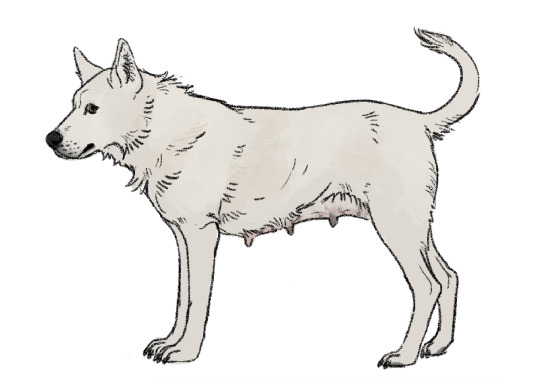
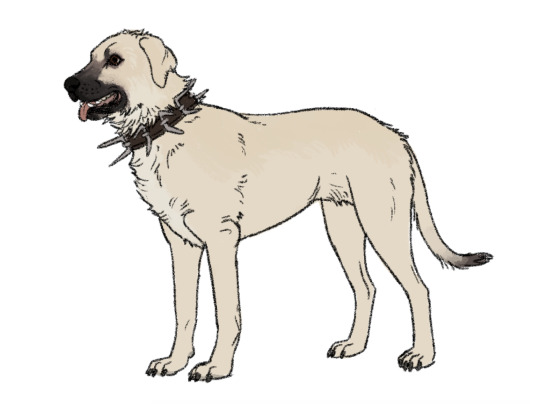
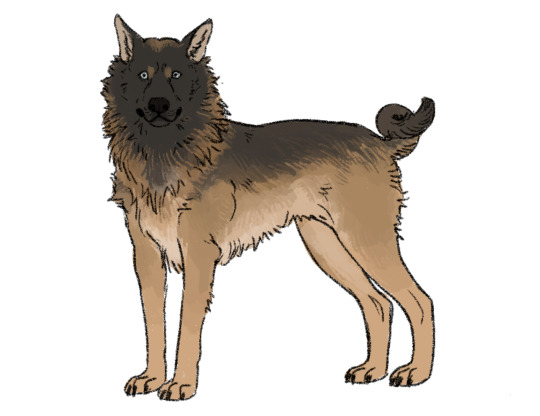
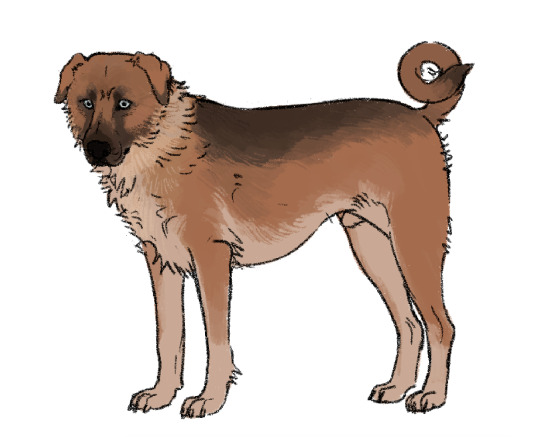
Four (relatively) distinct types of livestock guardian dogs in the Imperial Wardi region. (Left to right: hnorai dam, chin-tsimouna, dírgrahdain, and chin na Hittsanaedi)
Dog breeds in the modern sense of the word in which a dog is selected for highly specific physical traits and carefully bred to retain 'purity' is virtually nonexistent in this setting (and where similar practices occur, it's usually as an outlier situation surrounding a single dog rather than as a standard practice). Most working dogs first develop out of landraces via natural selection, and are bred according to their function above all else. Their forms are the results of natural pressures from their environments, the demands of their jobs, genetic isolation (or lack thereof), and often some degree of selectivity or preference for coloration or features.
These are the four types that occur within the region, all derived from a progenitor landrace guard dog (the last common ancestor of all four contemporary types probably existed about 950-1000 years before present). All share commonalities of a large size, rain-resistant hair, notably dense winter coats, a loud and deep bark, thick muzzles, and strongly sloping chests. They must be able to hold their own (usually through intimidation but occasionally in fights) against large predators that often physically outmatch them- lions, king hyena, hyenas, and wild dogs being most threatening to livestock. They also may have additional functions in dissuading theft and poaching of livestock by humans, and they may sometimes double as basic guard dogs of homes or villages.
Dogs here are bred almost entirely according to their function (you breed LGDs with LGDs, it doesn't usually matter if they look different or come from different stock), with the main exceptions being 'breeds' that are aspects of important cultural heritage or that have specific culturally/regionally preferred aesthetic traits. The chin-tsimouna is the most common of the three and is the result of minimally selective breeding (though some populations form unique strains or have a selective local status), while the other three are semi-isolated heritage types (the hnorai dam for some North Wardi groups, the dírgrahdain for most of the Hill Tribes, and the chin na Hittsanaedi among Ephenni Riverlanders).
---
Hnorai dam: Very rare in the contemporary, with undiluted animals of this stock surviving in some of the most isolated parts of the region's north. This type is distinct for typically having a somewhat stockier build than the others, solid coats, pointed ears, and a tail held upright and curved when relaxed. Most are solid white, gray, or black, and will often be assigned to horses of matching color. This is also the most 'basal' of the regional LGDs, a dog close to this in form (but probably not with solid coloration) was the common progenitor of all other livestock guardian breeds in the region. Variants on 'hnorai dam' are the common name, simply meaning 'guard dog' in the North Wardi language (as they are often used as village/household guards as well as livestock guardians).
Chin-tsimouna: This is the most ubiquitous type, occurring region-wide (and beyond) and used by a variety of peoples (throughout the core Imperial Wardi sphere and among the Cholemdinae, with some usage among the North Wardi, Hill Tribes, and Wogan). They have the most significant foreign ancestry (largely from Burri and Yuroma dogs) and most frequent 'crossbreedings' with feral populations. Due to these factors, the look of these dogs is highly variable (with the 'chin-tsimouna' name functionally being a catchall for any LGDs not of an otherwise specified type). There ARE some broad commonalities (beyond strictly the underlying features common to all these LGD types). The ears are rarely pointed, and usually are bent or lay flat. Fawn coloration with a melanistic mask is by far the most common, with white, gray, and black dogs coming in second (often semi-selectively bred or chosen to match the coats of their charges). Solid colored chin-tsimouna are very rare. There are numerous regional names for type-variants, but 'chin-tsimouna' is the most common descriptor for the overall type, meaning 'horse-dog' (in reference to their typical charges, who they uniquely live among).
Dírgrahdain: This is the native livestock guardian dog of the Highlands. They are the most physically distinctive from their counterparts, and their traits are among the most consistent (due to rarity of feral dog populations in their native range and their status in shared cultural heritage encouraging maintenance of their distinctive traits and discouraging crossbreeding). The most distinctive features are a dense mane, pointed ears, and tightly curled tail. An extended melanistic mask is highly common, and very pale 'evil eyes' are favored in this population, believed to be the most frightening to predators and evil spirits. The name dírgrahdain means 'liondog', mostly referring to their mane. [Extended dírgrahdain post here]
Chin na Hittsanaedi: This is the 'youngest' of the distinct types, and derives from a period of significant crossing between dírgrahdain and chin-tsimouna within the Ephenni riverlands (region south of the soutwestern Highlands, between and around the convergence of the Erubin and Nedachemi rivers) due to significant interaction and overlap of territory between the Ephenni and the West Rivers Hill Tribes under Imperial Burri occupation. The curled tail and pale eyes of the dírgrahdain is common in this population, though the pointed ears are rare and the 'mane' is less developed or absent. Most other traits are typical of the chin-tsimouna type. Dogs of this stock are mainly used in rural parts of the province of Ephennos, and their significance to aspects of modern era Ephenni cultural identity dissuades intentional breeding with both of their progenitor types. The name chin na Hittsanaedi means 'Riverlands dog' (more literally 'dog of the Riverlands').
#creatures#The chin na Hittsanaedi shown here depicts a conceivable coat pattern and appearance for Orange Son Of A Bitch of prev post
239 notes
·
View notes
Text
Round 3 - Reptilia - Ciconiiformes




(Sources - 1, 2, 3, 4)
Our next order are the Ciconiiformes, which contain one family, Ciconiidae, commonly called “storks”.
Storks are superficially similar to the unrelated cranes and herons, with a long neck, bill, and legs, but they are more heavy-set. They have large bills, with sizes and shapes that vary between genera, adapted to their different diets. Storks usually hunt by wading in shallow water, but some will also stalk through grasslands. Most storks eat frogs, fish, insects, earthworms, small birds, and small mammals. Some are also scavengers of carrion. Storks live all over the world, except for the North and South Pole. They live in a variety of habitats, and can survive in drier environments than other waterbirds, but they are most diverse and common in the tropics. Many stork species are migratory, and soar on thermals to conserve energy.
Storks range from being solitary breeders through loose breeding associations, to fully colonial, nesting in colonies of a few pairs to thousands of pairs. Some colonies may include other species of storks, cormorants, herons, egrets, ibises, and/or pelicans. Storks use trees in a variety of habitats to breed including forests, cities, farmlands, and large wetlands. Their nests are often very large and may be used for many years, with the pair returning and building onto it each year. Most storks are generally monogamous, but some species exhibit regular extra-pair breeding. Both parents take care of the young.
Like most families of aquatic birds, storks seem to have arisen in the Palaeogene, around 40–50 million years ago, with living genera dating back to the Middle Miocene (about 15 mya).

Propaganda under the cut:
The characteristic feeding method of storks involves standing or walking in shallow water and holding the bill submerged in the water. When contact is made with prey the bill reflexively snaps shut in 25 milliseconds, one of the fastest reactions known in any vertebrate. The stork is also able to sense whether its bill is making contact with prey or an inanimate object within those 25 milliseconds, and it is still not known how they do this.
Openbills (genus Anastomus) are specially adapted to feed on freshwater molluscs, particularly apple snails. They feed in small groups, and sometimes African Openbills (Anastomus lamelligerus) (image 4) ride on the backs of hippos while foraging. Having caught a snail it will return to land or at least to the shallows to eat it. The fine tip of the bill of the openbills is used to open the snail, and its saliva has a narcotic effect, which causes the snail to relax and simplifies the process of extraction.
Various terms are used to refer to groups of storks, two frequently used ones being a “muster” of storks and a “phalanx” of storks.
The Marabou Stork (Leptoptilos crumenifer) (image 2) is the largest stork, at a height of 152 cm (5 ft) tall and weight up to 8 kg (18 lb). With a wingspan of 3.2 m (10 ft 6 in), it joins the Andean Condor (Vultur gryphus) in having the widest wingspan of all living land birds.
Although it is sometimes reported that storks lack syrinxes and are mute, they do have syrinxes, and are capable of making some sounds, although they do not do so often. However, their syrinxes are "variably degenerate", and the syringeal membranes of some species are found between tracheal rings or cartilage, an unusual arrangement shared with the ovenbirds (family Furnariidae). Instead, storks mainly communicate by clattering their bills.
The two species in the genus Ephippiorhynchus are unique among storks for having colored sexual dimorphism. Saddle-billed Stork (Ephippiorhynchus senegalensis) (image 1) males have brown eyes and small yellow wattles, while the females have yellow eyes and no wattles. Black-necked Stork (Ephippiorhynchus asiaticus) males also have brown eyes while the females have yellow eyes.
Many ancient mythologies feature stories and legends involving storks. In Ancient Egypt, Saddle-billed Storks were seen as being amongst the most powerful animals and were used to represent the ba, the Ancient Egyptian conception of the soul, during the Old Kingdom.
Greek and Roman mythology portrays storks as models of parental devotion. Storks were thought to care for their aged parents, feeding them and even transporting them, and children's books depicted them as a model of filial values. The 3rd century Roman writer Aelian, noted in his De natura animalium that aged storks flew away to oceanic islands where they were transformed into humans as a reward for their loyalty towards their parents. The Greeks held that killing a stork could be punished with death.
According to European folklore, the White Stork (Ciconia ciconia) (see gif above) is responsible for bringing babies to new parents. German folklore held that storks found babies in caves or marshes and brought them to households in a basket on their backs or held in their beaks. The babies would then be given to the mother or dropped down the chimney. Households would notify when they wanted children by placing sweets for the stork on the windowsill. Subsequently, the folklore has spread around the world to the Philippines and countries in South America. In Slavic mythology and pagan religion, storks were thought to carry unborn souls from Vyraj to Earth in spring and summer. This belief still persists in the modern folk culture of many Slavic countries, in the simplified child story that "storks bring children into the world".
#animal polls#so many shoebills show up when you search for storks in the gifs on here#surprise mfs that’s not a stork#that guy’s coming in two days#round 3#reptilia#Ciconiiformes#edit: wth happened to all my links
93 notes
·
View notes
Text
access problem fixed, it was just an expired login token (as i use an ssh key so the token doesnt get renewed every login). start python script. same weird syntax error as before?? manually execute my bash file (which should happen automatically but ive given up on that one months ago). suddenly the syntax error is gone????
#tütensuppe#no clue whatsoever but its running now at least#also environment variables work! i pushed a new version and now you can just#import the setup script run the command i set and you can use the specialized python libs!!
0 notes
Text
On Celebrating Errors

Isn't it beautiful? The lovely formatted tables of register and stack contents, the trace of function addresses and parameters, the error message ... it's the most beautiful kernel panic I have ever seen.
Why on earth would I be so excited to see a computer crash? What could possibly be beautiful about a kernel panic?
This kernel panic is well-earned. I fought hard to get it.
This kernel panic came from a current NetBSD kernel, freshly compiled and running on Wrap030, my 68030 homebrew computer. It is the result of hours upon hours of work reading through existing code, scattered documentation and notes, writing and rewriting, and endless compiling.
And it's just the start.
As I've said before, a goal of this project has always been to build something capable of running some kind of Unix-like operating system. Now that I finally have all the necessary pieces of hardware, plus a good bootloader in ROM, it's time to give it a shot. I'm not that great with this type of programming, but I have been getting better. I might just be able to brute force my way through hacking together something functional.
It is hard.
There is some documentation available. The man(9) pages are useful, and NetBSD has a great guide to setting up the build environment for cross-compiling the kernel. There are some published papers on what some people went through to port NetBSD to this system or that. But there's nothing that really explains what all these source code files are, and which parts really need to be modified to run on a different system.
I had a few false starts, but ultimately found an existing 68k architecture, cesfic, which was a bare minimum configuration that could serve well as a foundation for my purposes. I copied the cesfic source directory, changed all instances of the name to wrap030, made sure it still compiled, then set about removing everything that I didn't need. It still compiled, so now it's was time to add in what I did need.
... how ... do I ... ?
This is where things get overwhelming very quickly. There is documentation on the core functions required for a new driver, there's documentation on the autoconf system that attaches drivers to devices in the tree, and there's plenty of drivers already to reference. But where to start?
I started by trying to add the com driver for the 16550 UARTs I'm using. It doesn't compile because I'm missing dependencies. The missing functions are missing because of a breaking change to bus.h at some point; the com driver expects the new format but the cesfic port still uses the old. So I needed to pull in the missing functions from another m68k arch. Which then required more missing functions and headers to be pulled in. Eventually it compiled without error again, but that doesn't mean it will actually run. I still needed to add support for my new programmable timer, customize the startup process, update hardware addresses, make sure it was targeting 68030 instead of 68040 ...
So many parts and pieces that need to be updated. Each one requiring searching for the original function or variable declaration to confirm expected types or implementation, then searching for existing usages to figure out what it needs ... which then requires searching for more functions and variable types.
But I got something that at least appeared to have all the right parts and compiled without error. It was time to throw it on a disk, load it up, and see what happened.
Nothing happened, of course. It crashed immediately.
I have no debugging workflow I can rely on here, and at this stage there isn't even a kernel console yet. All I could do was add little print macros to the locore startup code and see where it failed. Guess, test, and revise.
I spent a week debugging the MMU initialization. If the MMU isn't properly configured, everything comes to an abrupt halt. Ultimately, I replaced the cesfic machine-specific initialization code and pmap bootstrapping code with functions from yet another m68k arch. And spent another day debugging before realizing I had missed a section that had comments suggesting it wasn't for the 68030 CPU, but turned out to be critical for operation of kernel memory allocation.
Until this point, I was able to rely on the low-level exception handling built into my bootloader if my code caused a CPU exception. But with the MMU working, that code was no longer mapped.
So then came another few hours learning how to create a minimal early console driver. An early console is used by the kernel prior to the real console getting initialized. In this case, I'm using the MC6850 on my mainboard for the early console, since that's what my bootloader uses. And finally the kernel was able to speak for itself.
It printed its own panic.
The first thing the kernel does is initialize the console. Which requires that com driver and all the machine-specific code I had to write. The kernel is failing at its step #1.
But at least it can tell me that now. And given all the work necessary to get to this point, that kernel panic data printing to the terminal is absolutely beautiful.
#troubleshooting#coding#os development#netbsd#homebrew computer#homebrew computing#mc68030#motorola 68k#motorola 68030#debugging#wrap030#retro computing
69 notes
·
View notes
Text
i guess i would technically be considered a "revivalist" because the view i approach helpol with is very focused on what it means to be a living religion and what it means to bring a religion back to life. but that's also the exact reason i'm so attached to historically backed-up practices and learning about the real history of helpol.
this religion was always both extremely localized and deeply familial. religious worship was always tied to kinship because it was something taught to you by your parents according to their specific familial customs. in that sense all worship is ancestral to some degree; how you practice connects you to your ancestors as much as worshipping them directly. and connected to that is how much worship revolved around people's specific local environments. people had a deep spiritual relationships with their local rivers and mountains and trees. festivals were attached to the harvests and seasonal patterns of individual cities. the religion is tied together as one group because of overarching shared characteristics, but the specifics have always been variable not by accident but because of how much family and nature are central to everyday worship and those simply cannot be generalized.
obviously the literal kinship cycle is broken; none of us have been taught how to worship by actual ancient greek family members, and the vast majority of people are not raised in a pagan household in any regard. but i do consider ancient helpol practioners spiritual kin, in a sense. they are the reason any of us worship the theoi at all. i feel honoring them means, alongside learning about & caring for modern greece, learning about their practices and what distinguishes helpol in general from other spiritual frameworks, things like kharis and miasma and xenia. but i don't just want to take everything literally; i am not athenian and i don't live in attica and have no real intention of every doing so. the things that were of primary relevance in the lives of classical athenians do not necessarily play a role in my material everyday life. it feels more spiritually authentic for me to worship the chesapeake bay in a helpol manner or to give a god a new epithet based on their role in my life. helpol as a living religion is meant to change to fit the needs and realities of practioners. that's not something to be opposed to a historically-based practice. sometimes appreciating the history is what makes you want to adapt and modernize.
helpol is not (with all due respect) a plug-and-play (plug-and-pray?) religion like Christianity where there is a set of standardized rules that every practitioner adopts. the rivers of greece are beautiful but why should i focus my soul on them, when there are waterways that actually raised me? why should i imitate the ancients' relationship with their mountains when i can focus on the impact my actual local mountains have had on me?
96 notes
·
View notes
Note
Hey, you're such a huge inspiration to me and I'm obsessed with your artstyle. I'm currently studying concept art and I want to learn/understand how to create form and lighting and genuinely how to start and finish an artwork. Do you have any speed paints or progress videos of your works? If so, I would love to understand your thinking process
Thx♥️♥️
hiiii
tysm!
big thing, concept art, my first inspirations in digital. Good luck!
Here is a look at the beginning of a work and the finish.. I have a youtube channel where I have uploaded full timelapse, but there is no recent I don't think there. The last timelapse from 2023? My YT is: nonnydoge
Set in the core of what you need to paint and then work at it. Simple. Jk it is not that simple but it is my thought😵💫
Light is your #1. Keep your light in mind always. When you are in control of your light, you are in control of your logic, then you are in control of your forms easily.
Looking down at a table and looking at side of the table will give you a different "color" of the table


yeah these are not the same table but I am too lazy to open blender rn. But you will get the same effect in variable strength regardless. The table is brown, but at a different angle, the angle most flat, will show you a paler, whitish, top. This is fresnel effect. This effect shows us how perspective is important to keep in mind with light and form.
you will see nothing without light, and it is your responsibility as the painter, creator, mark maker to make every stroke adhere to the logic of your light. You need to think constantly, it is a good workout.
But it is like math, that, when you know the formulas, equations then are done swiftly, though you still need to dedicate time to solving them. This is what skill in art gets you. Fast logic.
It is the logic of our world, so it is not like you need to invent. Though you are adding any light sources you want, light, and how light will act, can be logically added to your scenes with confidence.
I am sure you have already seen that art, the one with a ball lit from above accompanied with arrows and words telling you how light is affecting it. I dismissed this when I was starting; I found it boring. But, it is all you need, truthfully. It is giving you the answers to light's logic. It is super simple.
Once you know the core shadow, ambient light, diffuse light, core light etc.... you are set, really. Of course, we need to practice a lot, but that is the truth to light. There is not much to it, and it is easily manageable because it is logical.

did this a while ago for fun. I recommend taking an image and doing something like this. Labeling what you see, how you find light is affecting the subject, how the environment is providing context.
one of my favorite stages of the art process is doing this to my own paintings, though I do it in my head. Following my light paths, checking the logic I set up and see if it makes sense. I do a lot of work from imagination, so it is important I know the logic and can effectively check my self and my work. With reference, because the light is found out for you, instead of directly copying, do the checking process in your head. The answers are true as it is a photo, though be careful as photos can be heavily edited so studying from life is the best way to check.
It is like algebra and being presented with a solved problem, and instead of copying it, you analyze and compare to your formulas
Finishing an artwork requires evaluation and correction. Starting an artwork requires you to develop context that logic must hang to. Throughout a render, responsibility is key. And patience!
That is how I think while I paint.
texture, angle, local color, environmental light and colors, circumstance of the material etc. are all important to understand when painting any subject. Yes light is essential, but so is perspective as said at the beginning.
I hope I have helped somewhat!

66 notes
·
View notes
Text
People like intrigue…but they are also impatient.
How would you react if/when Lukola officially launched as a couple? Here are some outcomes I think would happen:
-Lukola’s will be happy. I think most of them will continue to follow both Nic and Luke, but many of them will slowly start to engage less and less with them on SM.
-Antuke’s and Jakola’s will be disappointed/upset/mad and a lot will stop following Nic and Luke.
-The GA will be happy for them (because they saw what they saw at the SAG’s, and caught on to what could be happening). They will continue to follow them in the same manner they had before.
-TikToks, Tumblr blogs, and X posts about them will go down significantly, as people are either happy they are together or sad that they are not with their adjacent’s.
I DO believe in possible NDA’s and other agreements going on bts. I think there could possibly be more at play though.
I fully believe that they (or members of their team) are constantly on SM (including tumblr blogs), finding out what the fandom is saying about them. I believe that they are fully aware of the split fandoms (Lukola, Jakola, Antuke) and what each fandom (and sub-fandom) is saying about them. I also think they are fully aware that by not launching, how many people in these groups continue to talk and speculate about them.
Nic and Luke are both pretty new to fame and what comes with it. I don’t believe that either one of them loves dealing with the not so fun parts of fame. However, I think they realize that they need to adjust (and most likely do some things that they are not 100% comfortable with). I think along with that, sometimes they have to “play the game”.
Now, being an actor can seem glamorous, and I believe it is, to an extent. However, acting is so much different than a “normal” job.
“Normal” jobs can have all kinds of variables (working different times of the day, working long hours or overtime, working in different environments, and having different schooling or training to get the job). However, they have one thing in common. They are constant and consistent for the most part.
When a person applies for a job, and gets it, they will work at that job until one of 3 main things happen. They could decide to quit and get a job elsewhere, they could be fired for various reasons, or they could be laid off either because the company is shrinking, moving, or going out of business.
Actors don’t get the kind of job security that people with “normal” jobs have. They work more like contractors. They have to go on a lot of auditions and do a lot of networking to get jobs or brand deals. They are constantly looking for their next job, by going on more auditions and doing more networking.
Unlike a lot of jobs that have set hours or set days that they work, actors do not. They have work when they are rehearsing or filming/performing. They are also working/networking when they go to events, when they promote the projects they are working on, or even when they are in public and fans want to interact with them. They are constantly working.
Sometimes they do luck out and get a recurring role in a long standing series. However, every series is not the same. Some series have a season to put out every year, so they are busier and the actors in them maybe don’t have as much time to do other projects in between filming.
Streaming shows generally do not have a season every year. For Nic and Luke, being part of an ongoing series that is more spaced out in the timing they film leaves them with time in between filming Bridgerton (and even some time during the filming of Bridgerton since they are no longer our leads) that they might want or need to fill with other projects.
Part of what people looking to hire actors look for is how many followers actors have on social media, how they engage with their fans and how much their fans are invested in what they are doing.
For brand deals, companies want to make sure that their spokesperson is well liked, popular and influential on their fans. For movies, series, and theater, producers and directors want to make sure that people’s interest is not only in the type of production they are putting out, but also that the actors in their production will bring fans and followers who will want to see the production simply because an actor is in it. So many are looking at the popularity of an actor.
I think Nicola and Luke are playing the long game. I think they want to have as many people following them, engaging with them and talking about them as possible.
With filming for Season 4 wrapping up (and without even an announcement of a season 5, for which filming would be a good amount of time away), both Nic and Luke are probably looking for new projects right now. This is NOT the time they want to publicly launch a relationship, losing them followers and engagement.
I don’t believe there will be a launch in the very near future. However, I fully believe that they will launch in plenty of time before Season 4 comes out, so that they don’t take away from build up for that season and its leads.
On to my opinions about the British Vogue and Netflix BAFTA party last night…
Nic and Luke’s PR teams are trying to push a certain narrative. This narrative is that Nicola is with Jake and Luke is with Antonia.
In my opinion, Nic is working overtime trying to sell this by lovingly looking at Jake with smiles that don’t quite reach her eyes. Luke, on the other hand, is having a rough go of it as he seems to really dislike being around Antonia and is having a hard time not showing his true emotions.
Speaking of true emotions, both Luke and Nicola could not keep their true emotions from showing at the SAG’s. Even the GA clocked how happy they seemed to be together.
I believe because of the reaction to the SAG’s, Nic and Luke were not allowed to be anywhere near one another last night. The PR team did not want a repeat of the SAG’s.
I know we got a couple pictures of Luke and Antonia this morning where Luke is actually smiling! Wow! I know the PR teams (and possibly Nic and Luke themselves) read these Tumblr blogs. They KNOW the things that are said about how miserable Luke looks.
I think one of two things brought on those happy pictures of the two of them (after more than a year…come on!!). I think either Luke was told he HAD to step it up and make it believable (look happy with her), or this is the final obligation he has to her (come on…how on EARTH did she get a solo photo on the red carpet??) and he IS genuinely happy that this is the last thing (and it is finally “done” as far as obligation goes).
As I write this, Luke just posted Antonia to his grid for the very first time ever. The timing screams obligation to me. Also, a kiss on the cheek can easily be referred to as a friend thing at a later time. He also did not tag her on their picture.
I believe that Nic will like it pretty quickly to continue to sell the narrative. I mean, she does follow Antonia on Insta now…so they are friends, right? If that is the case though…why is there not a pic from last night of the three of them being chummy and having a good time? Huh? Could it be the fact that Nic and Luke CAN’T hide their true feelings about one another when they are together?
I continue to be unbothered and still happily waiting for the truth to come out.
68 notes
·
View notes